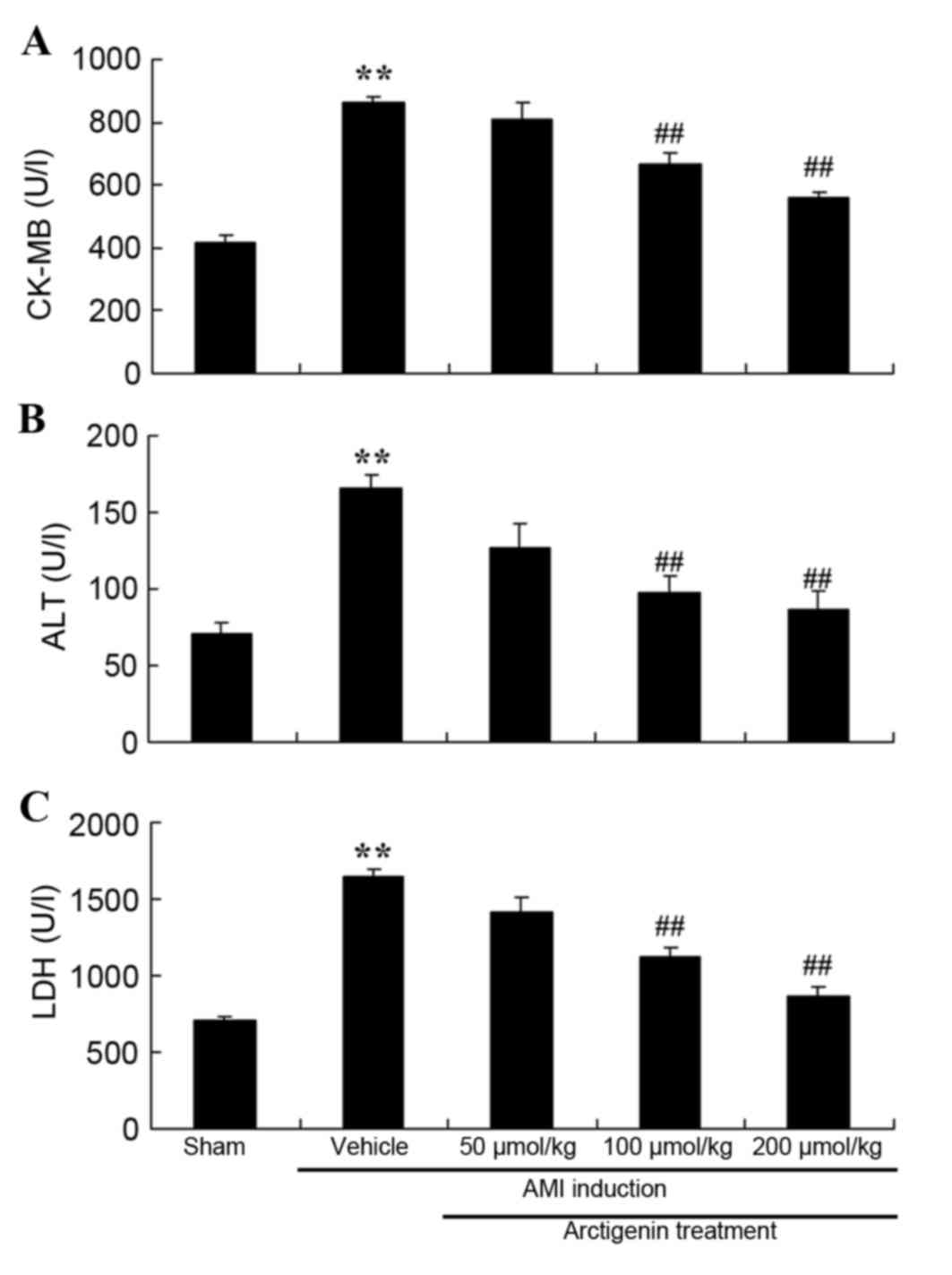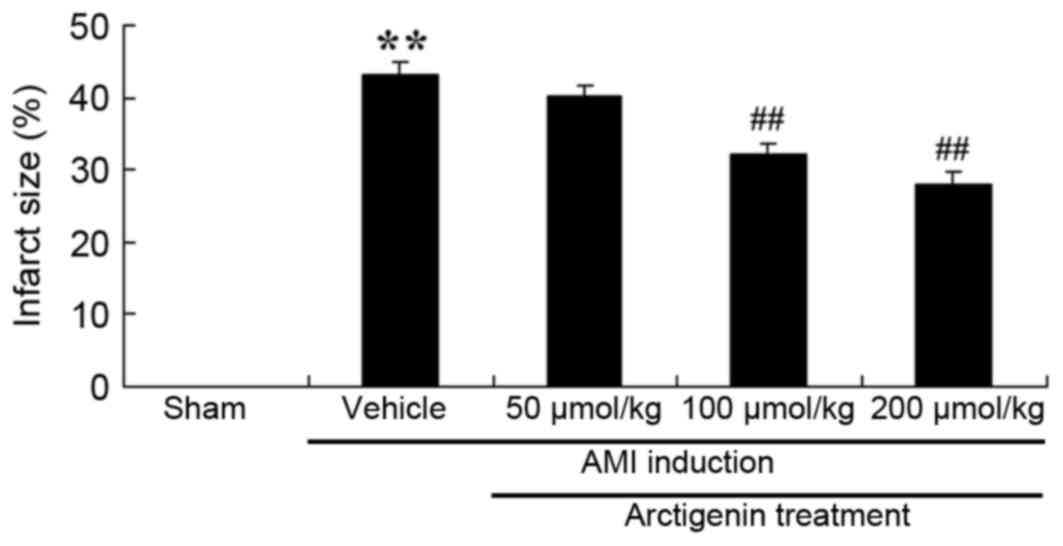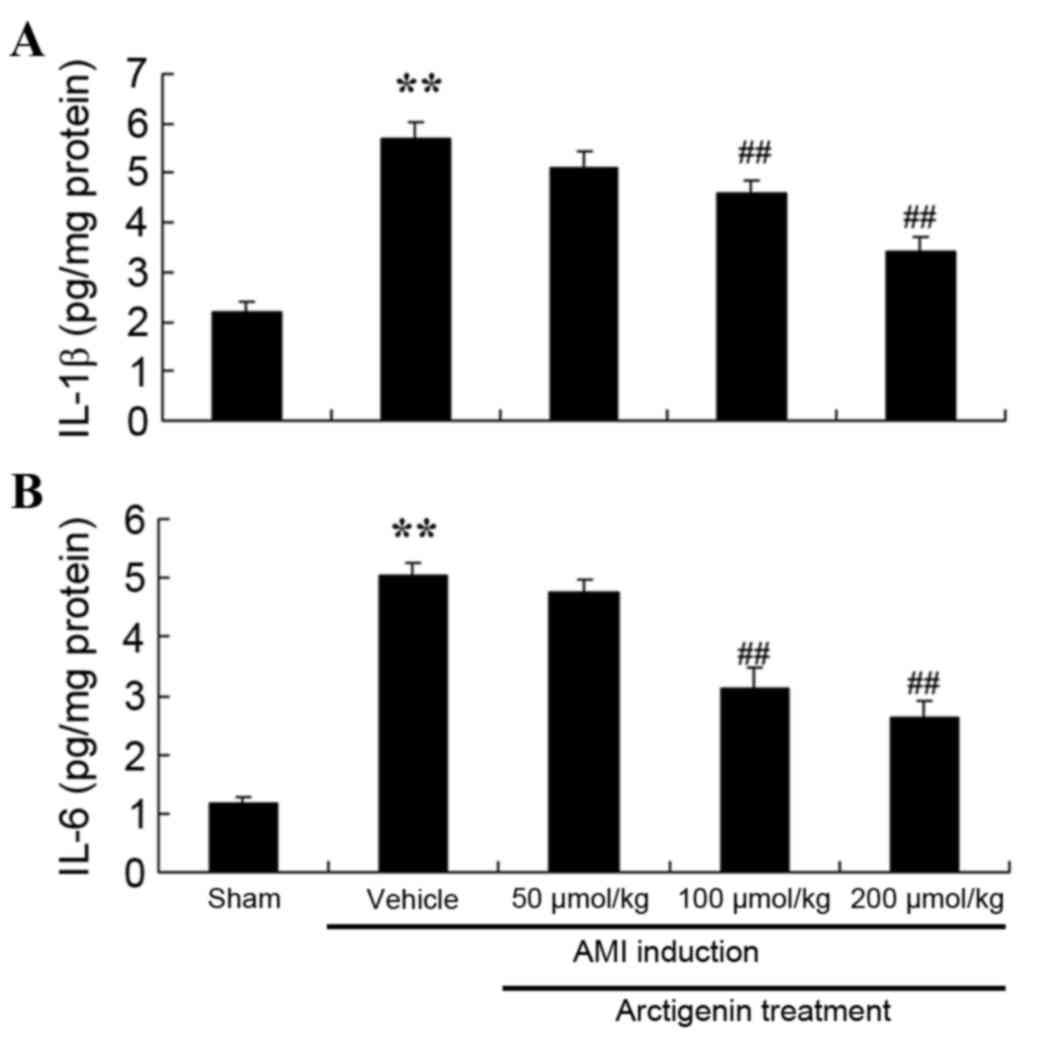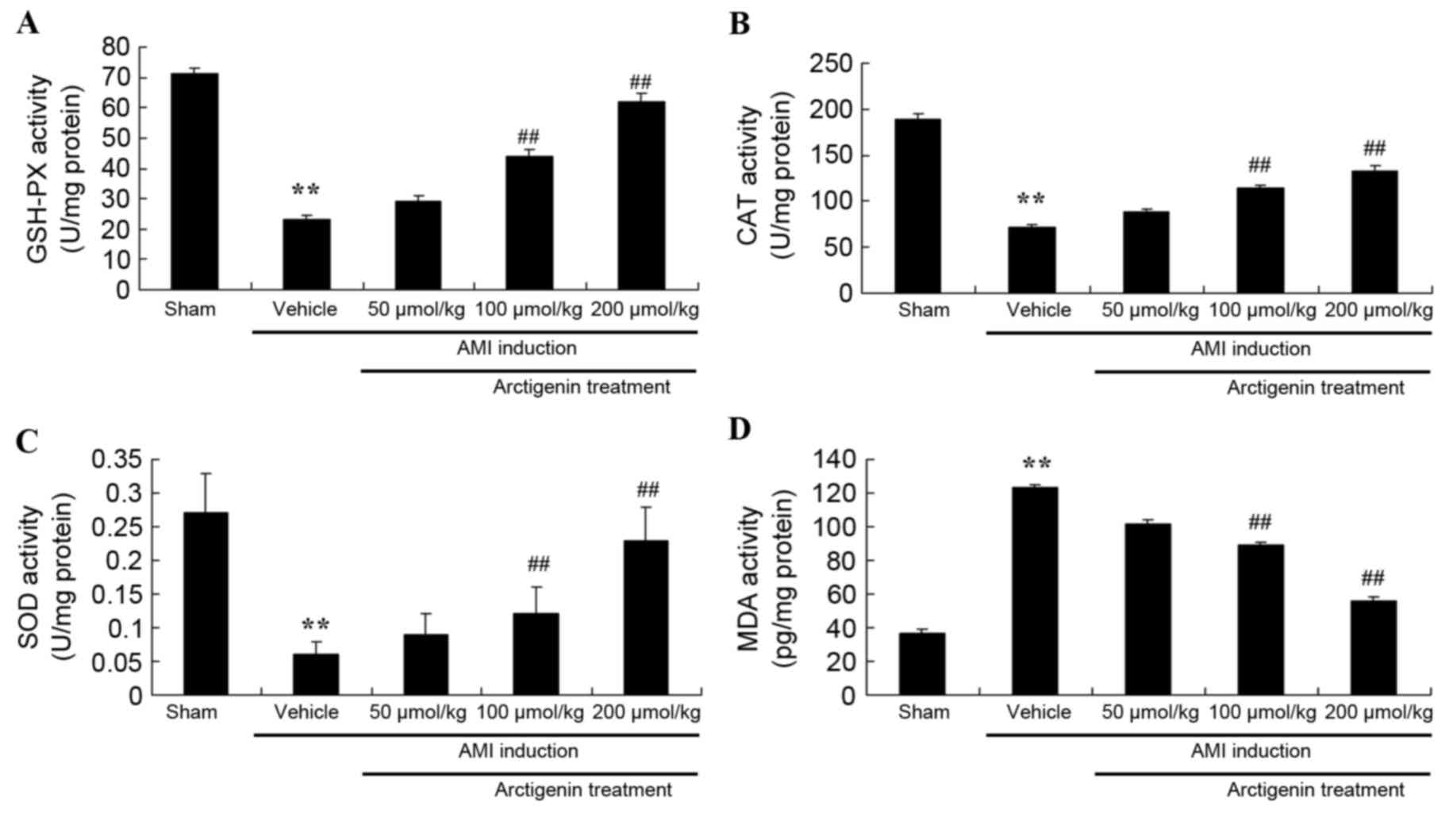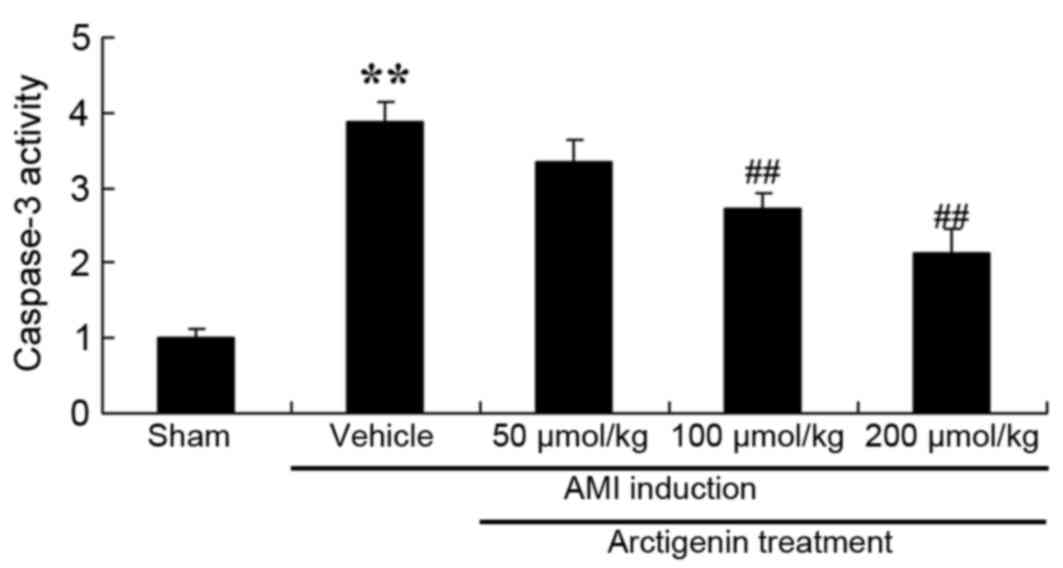Arctigenin exerts protective effects against myocardial infarction via regulation of iNOS, COX‑2, ERK1/2 and HO‑1 in rats
- Authors:
- Published online on: January 10, 2018 https://doi.org/10.3892/mmr.2018.8420
- Pages: 4839-4845
Abstract
Introduction
Acute myocardial infarction (AMI) may cause irreversible damage to functional myocardial cells, negative myocardial remodeling and progressive deterioration of cardiac function (1). In addition, it remains the primary cause of disease incidence and mortality in China (1). According to the Heart Disease and Stroke Statistics report by the American Heart Association (2), ~2,200 patients succumbed to cardiovascular diseases every day in 2008. In addition, an average of 785,000 cases of coronary atherosclerosis (3) and an average of 195,000 cases of MI are reported annually in China. AMI is the most serious type of coronary heart disease, which involves cardiomyocyte necrosis due to long-term ischemia and oxygen deficit. In addition, oxidative stress has significant effects on the pathological alterations associated with MI (4).
AMI may cause aerobic metabolic disorders due to long-term ischemia and hypoxia caused by coronary occlusion, which may lead to myocardial cell interstitial hyperemia, edema and degenerative necrosis, accompanied by increased inflammatory cell infiltration (5). Oxidative damage, caused by the excessive generation of free radicals and oxygen free radicals in cardiac tissue, results in damage to the structure and function of myocardial cell membranes, mitochondrial damage and autolysis (6). Myocardium under accelerated ischemia may progress from reversible injury to irreversible degenerative necrosis (7). Malignant arrhythmia may also occur, which may lead to further ventricular remodeling and cardiac dysfunction. Revascularization and reperfusion therapy are currently considered the most effective therapeutic methods; however, ischemia reperfusion can cause further damage to the remaining myocardium. The important mechanism underlying this damage may be oxidative stress (7). The longer the duration of ischemic and hypoxic conditions, the more evident the oxidative stress response will be in myocardial cells. In accordance, the higher the degree of myocardial injury, the heavier the state of illness will be (8).
Great Burdock (Arctium lappa) Achene extract is used in traditional Chinese medicine to treat anemopyretic cold, measles, carbuncles, ingested poison and other diseases (9). Modern pharmacological research has demonstrated that Great Burdock Achene extract possesses antibiotic, antitumor and hypoglycemic effects (10). Arctigenin (Fig. 1) is one of the active ingredients extracted from Great Burdock Achene, which has numerous pharmacological effects, including antitumor and neuroprotective activities; arctigenin also has strong anti-inflammatory, immunoregulatory and antiviral activity, and inhibits the heat-shock response (11,12). The present study aimed to evaluate the protective effects of arctigenin against MI and the potential underlying mechanisms.
Materials and methods
AMI model rats
The present study was approved by the Ethics Committee of Liaocheng People's Hospital of Shandong Province (Liaocheng, China). A total of 40 male Sprague-Dawley rats (weight, between 250 and 300 g; age, 10–12 weeks), were purchased from Jinan Jinfeng Experimental Animal Co., Ltd. (Shandong, China) and housed at 22–24°C and 55% humidity in an animal room under a 12-h light/dark cycle with free access to water and food. The present study was performed in accordance with the recommendations from the Guide for Animal Management Rules from the Ministry of Health of Liaocheng People's Hospital of Shandong Province. To generate the AMI model, rats were anesthetized by peritoneal injection with 1% pentobarbital (40 mg/kg). Subsequently, coronary arteries were exposed and the descending branch of the left anterior coronary artery was marked with silk and ligated for 1 h with hemostatic forceps; the wound was sutured (1–2 cm) following ligation in order to generate the AMI model.
Treatment groups
A total of 40 male Sprague-Dawley rats were randomly assigned into the following subgroups (n=8 rats/group): i) Sham group, which was used as a control (treated with normal saline); ii) AMI model group (vehicle control; AMI rats were treated with normal saline following the generation of the AMI model; iii) AMI rats treated with 50 µmol/kg arctigenin (Sigma-Aldrich; Merck KGaA, Darmstadt, Germany) following the generation of the AMI model; iv) AMI rats treated with 100 µmol/kg arctigenin following the generation of the AMI model; and v) AMI rats treated with 200 µmol/kg arctigenin following the generation of the AMI model. Rats were sacrificed following treatment with arctigenin for 1 week.
Measurement of alanine transaminase (ALT), creatine kinase (CK)-MB, lactate dehydrogenase (LDH), malondialdehyde (MDA), glutathione peroxidase (GSH-PX), catalase (CAT), superoxide dismutase (SOD), interleukin (IL)-1β and IL-6 activity
Following arctigenin treatment, blood was immediately collected from the abdominal aorta and used to analyze the serum levels of ALT (cat. no. C009-2), CK-MB (cat. no. H197), MDA (cat. no. A003-1), GSH-PX (cat. no. A005), CAT (cat. no. A007-1), SOD (cat. no. A001-1), IL-1β (cat. no. H002) and IL-6 (cat. no. H007) using Commercial ELISA kits (Nanjing Jiancheng Bioengineering Institute, Nanjing, China) according to the manufacturer's instructions.
Measurement of caspase-3 activity
Following arctigenin treatment, mice were sacrificed and their hearts were removed and homogenized in ice-cold radioimmunoprecipitation lysis buffer (Beyotime Institute of Biotechnology). Protein concentrations were measured using a Bicinchoninic Acid Protein Assay kit (Beyotime Institute of Biotechnology). Proteins (10 µg) were then incubated with the caspase-3 substrate, Ac-DEVD-pNA (cat. no. C1115; Beyotime Institute of Biotechnology) for 2 h at 37°C in order to measure caspase-3 activity, according to the manufacturer's protocol.
Evaluation of infarct size
Following arctigenin treatment, rats were sacrificed and the hearts were removed. The hearts were sliced into five sections (1.0 mm) perpendicular to the long axis, and the sections were incubated with 1% 2,3,5-triphenyl tetrazolium chloride (Sigma-Aldrich; Merck KGaA) in phosphate solution at 37°C for 10 min. Infarct sizes were determined by computer morphometry using Image-Pro Plus 6.0 software (Media Cybernetics, Inc., Rockville, MD, USA).
Western blot analysis
Following arctigenin treatment, mice were sacrificed and their hearts were removed and homogenized in ice-cold radioimmunoprecipitation lysis buffer (Beyotime Institute of Biotechnology). Protein concentrations were measured using the Bicinchoninic Acid Protein Assay kit (Beyotime Institute of Biotechnology). Proteins (80 µg/lane) were separated by 10% SDS-PAGE and were transferred to polyvinylidene fluoride membranes (EMD Millipore, Billerica, MA, USA). Membranes were blocked with 5% skim milk powder for 1 h at 37°C and probed with antibodies against inducible nitric oxide synthase (iNOS; cat. no. sc-649; 1:500; Santa Cruz Biotechnology, Inc., Dallas, TX, USA), cyclooxygenase 2 (COX-2; cat. no. sc-7951; 1:500; Santa Cruz Biotechnology, Inc.), phosphorylated-extracellular signal-regulated kinase 1/2 (p-ERK1/2; cat. no. sc-101761; 1:500; Santa Cruz Biotechnology, Inc.), ERK1/2 (cat. no. 4695; 1:2,000; Cell Signaling Technology, Inc., Danvers, MA, USA), heme oxygenase-1 (HO-1; cat. no. sc-10789; 1:500; Santa Cruz Biotechnology, Inc.) and β-actin (cat. no. sc-7210; 1:500; Santa Cruz Biotechnology, Inc.) at 4°C overnight. Membranes were then incubated with horseradish peroxidase-conjugated goat anti-mouse secondary antibodies (cat. no. 7074; 1:5,000; Cell Signaling Technology, Inc.) for 1 h at room temperature, and the immune complexes were detected by enhanced chemiluminescence (Cell Signaling Technology, Inc.). The optical densities of immunopositive bands were determined by Gene Tools image analysis (Syngene, Frederick, MD, USA) and Bio-Rad Quantity One software v3.0 (Bio-Rad Laboratories, Inc., Hercules, CA, USA).
Statistical analysis
Data are presented as the mean ± standard deviation of 3 independent experiments. Analysis was performed using SPSS v17.0 software (SPSS, Inc., Chicago, IL, USA). Statistical comparisons between groups were conducted using one-way analysis of variance and the Tukey post hoc test. P<0.05 was considered to indicate a statistically significant difference.
Results
Arctigenin reduces CK-MB, ALT and LDH levels in AMI rats
The present study evaluated the protective effects of arctigenin by analyzing the levels of biochemical markers of AMI in the rat model, including CK-MB, ALT and LDH (Fig. 2). The levels of CK-MB, ALT and LDH were higher in the AMI model rats compared with the Sham group. However, treatment with arctigenin (100 or 200 µmol/kg) significantly reduced the levels of CK-MB, ALT and LDH compared with in the untreated AMI control group (Fig. 2).
Arctigenin treatment reduces infarct size in AMI rats
To confirm the protective effects of arctigenin on AMI, the infarct size in AMI rats was examined. As presented in Fig. 3, the infarct size in AMI rats was significantly increased compared with the Sham group, whereas treatment with arctigenin (100 or 200 µmol/kg) markedly reduced the infarct size compared with untreated AMI rats (Fig. 3).
Arctigenin reduces inflammation in AMI rats
The effects of arctigenin on AMI-induced inflammation were investigated by examining the activity of IL-1β and IL-6 (Fig. 4). Untreated AMI model rats exhibited a significant increase in IL-1β and IL-6 activity compared with the Sham group. Conversely, treatment with 100 or 200 µmol/kg arctigenin significantly reduced the activity of IL-1β and IL-6 compared with the untreated AMI group (Fig. 4).
Arctigenin decreases oxidative stress in AMI rats
The effects of arctigenin on AMI-induced oxidative stress in AMI rats were examined. As shown in Fig. 5A-C, AMI resulted in decreased GSH-PX, CAT and SOD activity compared with the Sham group. However, treatment with arctigenin (100 or 200 µmol/kg) significantly increased the activity of GSH-PX, CAT and SOD in AMI rats (Fig. 5A-C). Conversely, MDA activity was higher in AMI rats compared with the Sham group (Fig. 5D); MDA activity was subsequently reduced in AMI rats upon treatment with arctigenin (100 or 200 µmol/kg) (Fig. 5D). These results demonstrated that arctigenin may possess antioxidative effects in AMI, and thus may be effective as a clinical treatment for AMI.
Arctigenin reduces iNOS protein expression in AMI rats
Protein expression levels of iNOS were detected by western blot analysis (Fig. 6). iNOS protein expression was significantly increased in AMI rats, compared with the Sham group, and was lowered in AMI rats treated with arctigenin (100 or 200 µmol/kg).
Arctigenin reduces the protein expression levels of COX-2 in AMI rats
The effects of arctigenin on the protein expression levels of COX-2 in AMI rats were determined by western blot analysis (Fig. 7). COX-2 protein expression was significantly higher in AMI model rats compared with the Sham group. However, treatment with arctigenin (100 or 200 µmol/kg) significantly reduced the protein expression levels of COX-2 in AMI rats.
Arctigenin decreases p-ERK1/2 protein expression in AMI rats
The protein expression levels of p-ERK1/2 were analyzed by western blotting, in order to examine the underlying mechanisms involved in AMI (Fig. 8). The protein expression of p-ERK1/2 was induced in the AMI model group when compared with the Sham group (Fig. 8). Treatment with arctigenin (100 or 200 µmol/kg) significantly decreased the protein expression of p-ERK1/2 AMI rats (Fig. 8).
Arctigenin decreases the protein expression levels of HO-1 in AMI rats
To confirm the underlying mechanisms of arctigenin treatment in AMI rats, HO-1 protein expression was examined by western blotting. As shown in Fig. 9, AMI induction led to an increase in the protein expression levels of HO-1 in AMI rats compared with the Sham group. Elevated HO-1 protein expression was significantly reduced in AMI rats treated with arctigenin (100 or 200 µmol/kg) compared with untreated AMI rats.
Arctigenin reduces caspase-3 activity in AMI rats
The present study analyzed the effects of arctigenin on AMI-induced apoptosis in rat heart cells by measuring caspase-3 activity by ELISA. As shown in Fig. 10, caspase-3 activity was significantly increased in AMI rats, compared with the Sham group, whereas treatment with arctigenin (100 or 200 µmol/kg) significantly reduced caspase-3 activity in AMI rats (Fig. 10).
Discussion
AMI is an important pathological and lethal syndrome worldwide. Following occurrence of AMI, dredging the blocked coronary artery in a timely manner is the only effective therapeutic strategy to save ischemic myocardial tissue and to restore cardiac function (2). However, reperfusion injury may lead to damage or death of ischemic cardiac muscle cells (13). Effective methods for the treatment of myocardial reperfusion injury have been investigated; however, there is currently no definite strategy or drug available (14). Despite the common therapeutic strategy of timely ischemic myocardial perfusion recovery, 25% of patients with AMI will develop chronic cardiac failure as a result of reperfusion injury (15). Reperfusion injury is a key factor for myocardial injury associated with myocardial infarction recanalization; therefore, reducing reperfusion injury is conducive to myocardial cell survival, reducing the loss of myocardial function and reducing the probability of developing chronic cardiac failure (16). In the present study, treatment with arctigenin significantly lowered the AMI-induced levels of ALT, CK-MB and LDH, and reduced the infarct size in AMI model rats.
Oxidative stress refers to an imbalance of oxidation and antioxidation in the body (17). Oxidation may lead to granulocyte inflammatory infiltration, increased protease secretion and the production of a large amount of intermediate products (18). The degree of myocardial injury due to the increased levels of oxygen radicals in peripheral circulation can be evaluated through the change in activity of endogenous antioxidant enzymes, such as SOD, in the peripheral blood (17). Reduced glutathione is a tripeptide that is composed of glutamic acid, cysteine and glycine, and is expressed in various organs. It is a coenzyme that is involved in the activation of numerous other enzymes, participates in the Krebs cycle and sugar metabolism, and helps maintain physiological functions of the cell (19). Results from the present study revealed that the protective effects of arctigenin reduced oxidative stress and iNOS expression in AMI model rats. Kou et al (20) demonstrated that arctigenin decreased COX-2 expression and inhibited STAT1/3 expression, which led to a decrease in iNOS expression. In addition, Zhang et al (11) reported that arctigenin exerts protective effects against lipopolysaccharide (LPS)-induced oxidative stress and inflammation by suppressing HO-1 and iNOS signaling in mice.
Tumor necrosis factor-α (TNF-α) is a multifunctional protein that is mainly produced by the activated scavenger/mononuclear cell system. Normal myocardial cells cannot produce TNF-α (21); however, in the case of AMI pump failure, TNF-α expression increases significantly and becomes a reliable indicator by which to evaluate the clinical prognosis of AMI (22). IL-6 is a proinflammatory cytokine with numerous functions that is secreted by activated monocytes, macrophages, T lymphocytes, endothelial cells and fibroblasts (23). A previous study reported that IL-6 may be the most powerful predictor of mortality caused by cardiogenic shock in patients with AMI within 30 days (24). In the present study, AMI rats treated with arctigenin exhibited significantly decreased IL-1β and IL-6 activity.
Decreased coronary blood flow resulting from arterial thrombosis or atherosclerosis may lead to myocardial anoxia (25). In myocardial cells of neonatal rats cultivated in vitro, hypoxia led to an increase in the mRNA and protein expression levels of HO-1, whereas under normoxic conditions, HO-1 expression was reduced (26). Environment-induced hypoxia may lead to pulmonary hypertension and may induce right ventricular hypertrophy (27). HO-1-knockout mice under normoxic conditions exhibit normal behavior, whereas under hypoxic conditions, despite having a similar degree of pulmonary hypertension, HO-1 knockout mice were subject to more serious right ventricular dilation and infarction accompanied by atherothrombosis (28). In the present study, treatment with arctigenin significantly reduced the protein expression levels of HO-1 in AMI rats. Zhang et al (11) reported that arctigenin protects against LPS-induced oxidative stress and inflammation through suppression of HO-1 and iNOS signaling in mice.
Ischemic preconditioning is a procedure that prepares the myocardium to tolerate long-term ischemic damage by subjecting myocardiocytes to transitory periods of ischemia (29). A previous study demonstrated that COX-2 may be involved in the preadaptation process of myocardial ischemia and serves a key protective role (30). Conversely, COX-2 inhibitors prevent the protective effects of the ischemia preadaptation process by inhibiting the expression of prostaglandin I2 receptor (30). In addition, the delayed ischemic preconditioning protection mediated by COX-2-regulated opioid-type receptors of rat myocardium may be suppressed following treatment with the COX-2 inhibitor NS-398 (31). It has also been demonstrated that activation of opioid receptors may induce the delayed protective effects of ischemic preconditioning, which is dependent on COX-2 expression, to mitigate myocardial suppression and reduce myocardial infarct size (32). The present study demonstrated that treatment with arctigenin significantly reduced the protein expression levels of COX-2 in AMI model rats.
ERK1 and ERK2 are important members of the mitogen-activated protein kinase signaling pathway superfamily (33). They may be activated by growth stimulating factors, such as growth factors, cytokines and stretching, and are able to mediate various cellular responses, including cell growth, differentiation and apoptosis (34). In cell culture experiments, ERK1/2 agonists significantly enhance hypertrophy and hyperplasia of myocardiocytes (35). Furthermore, hypertrophic myocardial cells also exhibit increased functional ERK1/2 expression (36). In vivo experiments also demonstrated that ventricular hypertrophy due to acute or chronic pressure load may lead to varying degrees of increased ERK activity, whereas ERK activity decreases during periods of heart failure (36). The results of the present study demonstrated that treatment with arctigenin significantly decreased the protein expression levels of p-ERK1/2 in AMI rats. Li et al (37) reported that arctigenin may suppress transforming growth factor-β1 in renal tubular epithelial cells through the reactive oxygen species-dependent ERK/nuclear factor-κB signaling pathway.
In conclusion, the results of the present study revealed that the protective effects of arctigenin reduced the levels of ALT, CK-MB and LDH, and inhibited infarct size in AMI rats. Arctigenin also exhibited antioxidative and anti-inflammatory activities by suppressing the expression levels of iNOS, COX-2 and HO-1, and activating ERK1/2 signaling. These findings suggested that arctigenin may prove clinically useful in treating AMI.
References
|
Voors AA, von Haehling S, Anker SD, Hillege HL, Struck J, Hartmann O, Bergmann A, Squire I, van Veldhuisen DJ and Dickstein K; OPTIMAAL Investigators, : C-terminal provasopressin (copeptin) is a strong prognostic marker in patients with heart failure after an acute myocardial infarction: Results from the OPTIMAAL study. Eur Heart J. 30:1187–1194. 2009. View Article : Google Scholar : PubMed/NCBI | |
|
Wijnbergen I, Tijssen J, van't Veer M, Michels R and Pijls NH: Gender differences in long-term outcome after primary percutaneous intervention for ST-segment elevation myocardial infarction. Catheter Cardiovasc Interv. 82:379–384. 2013. View Article : Google Scholar : PubMed/NCBI | |
|
Young JJ, Cox DA, Stuckey T, Babb J, Turco M, Lansky AJ, Mehran R and Stone GW: Prospective, multicenter study of thrombectomy in patients with acute myocardial infarction: The X-Tract AMI registry. J Interv Cardiol. 20:44–50. 2007. View Article : Google Scholar : PubMed/NCBI | |
|
Baird SH, Menown IB, McBride SJ, Trouton TG and Wilson C: Randomized comparison of enoxaparin with unfractionated heparin following fibrinolytic therapy for acute myocardial infarction. Eur Heart J. 23:627–632. 2002. View Article : Google Scholar : PubMed/NCBI | |
|
Zhu XY, Zhang ZL, Li P, Liang WY, Feng XR and Liu ML: Shenyuan, an extract of American Ginseng and Corydalis tuber formula, attenuates cardiomyocyte apoptosis via inhibition of endoplasmic reticulum stress and oxidative stress in a porcine model of acute myocardial infarction. J Ethnopharmacol. 150:672–681. 2013. View Article : Google Scholar : PubMed/NCBI | |
|
Ghyasi R, Sepehri G, Mohammadi M, Badalzadeh R and Ghyasi A: Effect of mebudipine on oxidative stress and lipid peroxidation in myocardial ischemic-reperfusion injury in male rat. J Res Med Sci. 17:1150–1155. 2012.PubMed/NCBI | |
|
Neri M, Fineschi V, Di Paolo M, Pomara C, Riezzo I, Turillazzi E and Cerretani D: Cardiac oxidative stress and inflammatory cytokines response after myocardial infarction. Curr Vasc Pharmacol. 13:26–36. 2015. View Article : Google Scholar : PubMed/NCBI | |
|
Xie N, Zhang W, Li J, Liang H, Zhou H, Duan W, Xu X, Yu S, Zhang H and Yi D: alpha-Linolenic acid intake attenuates myocardial ischemia/reperfusion injury through anti-inflammatory and anti-oxidative stress effects in diabetic but not normal rats. Arch Med Res. 42:171–181. 2011. View Article : Google Scholar : PubMed/NCBI | |
|
Zhang Y, Wang Z, Chen H, Chen Z and Tian Y: Antioxidants: Potential antiviral agents for Japanese encephalitis virus infection. Int J Infect Dis. 24:30–36. 2014. View Article : Google Scholar : PubMed/NCBI | |
|
Shin HS, Jung SY, Back SY, Do JR and Shon DH: Arctigenin from fructus arctii (Seed of Burdock) reinforces intestinal barrier function in Caco-2 cell monolayers. Evid Based Complement Alternat Med. 2015:3681052015. View Article : Google Scholar : PubMed/NCBI | |
|
Zhang WZ, Jiang ZK, He BX and Liu XB: Arctigenin protects against lipopolysaccharide-induced pulmonary oxidative stress and inflammation in a mouse model via suppression of MAPK, HO-1, and iNOS signaling. Inflammation. 38:1406–1414. 2015. View Article : Google Scholar : PubMed/NCBI | |
|
Fan T, Jiang WL, Zhu J and Feng Zhang Y: Arctigenin protects focal cerebral ischemia-reperfusion rats through inhibiting neuroinflammation. Biol Pharm Bull. 35:2004–2009. 2012. View Article : Google Scholar : PubMed/NCBI | |
|
Xu F, Ming Q and Hou L: The effect of sex counselling in the sexual activity of acute myocardial infarction patients after primary percutaneous coronary intervention. Acta Cardiol. 70:460–464. 2015. View Article : Google Scholar : PubMed/NCBI | |
|
Limalanathan S, Andersen GO, Klow NE, Abdelnoor M, Hoffmann P and Eritsland J: Effect of ischemic postconditioning on infarct size in patients with ST-elevation myocardial infarction treated by primary PCI results of the POSTEMI (POstconditioning in ST-Elevation Myocardial Infarction) randomized trial. J Am Heart Assoc. 3:e0006792014. View Article : Google Scholar : PubMed/NCBI | |
|
Palmerini T, Brener SJ, Mehran R, Dangas G, Genereux P, Riva DD, Mariani A, Xu K and Stone GW: Leukocyte count is a modulating factor for the mortality benefit of bivalirudin in ST-segment-elevation acute myocardial infarction: The HORIZONS-AMI trial. Circ Cardiovasc Interv. 6:518–526. 2013. View Article : Google Scholar : PubMed/NCBI | |
|
Palmerini T, Brener SJ, Genereux P, Maehara A, Della Riva D, Mariani A, Witzenbichler B, Godlewski J, Parise H, Dambrink JH, et al: Relation between white blood cell count and final infarct size in patients with ST-segment elevation acute myocardial infarction undergoing primary percutaneous coronary intervention (from the INFUSE AMI trial). Am J Cardiol. 112:1860–1866. 2013. View Article : Google Scholar : PubMed/NCBI | |
|
Wang X, Wang Y, Jiang M, Zhu Y, Hu L, Fan G, Wang Y, Li X and Gao X: Differential cardioprotective effects of salvianolic acid and tanshinone on acute myocardial infarction are mediated by unique signaling pathways. J Ethnopharmacol. 135:662–671. 2011. View Article : Google Scholar : PubMed/NCBI | |
|
Bagatini MD, Martins CC, Battisti V, Gasparetto D, da Rosa CS, Spanevello RM, Ahmed M, Schmatz R, Schetinger MR and Morsch VM: Oxidative stress versus antioxidant defenses in patients with acute myocardial infarction. Heart Vessels. 26:55–63. 2011. View Article : Google Scholar : PubMed/NCBI | |
|
Lorgis L, Zeller M, Dentan G, Sicard P, Richard C, Buffet P, L'Huillier I, Beer JC, Cottin Y, Rochette L, et al: The free oxygen radicals test (FORT) to assess circulating oxidative stress in patients with acute myocardial infarction. Atherosclerosis. 213:616–621. 2010. View Article : Google Scholar : PubMed/NCBI | |
|
Kou X, Qi S, Dai W, Luo L and Yin Z: Arctigenin inhibits lipopolysaccharide-induced iNOS expression in RAW264.7 cells through suppressing JAK-STAT signal pathway. Int Immunopharmacol. 11:1095–1102. 2011. View Article : Google Scholar : PubMed/NCBI | |
|
Abe Y, Ito K, Hao K, Shindo T, Ogata T, Kagaya Y, Kurosawa R, Nishimiya K, Satoh K, Miyata S, et al: Extracorporeal low-energy shock-wave therapy exerts anti-inflammatory effects in a rat model of acute myocardial infarction. Circ J. 78:2915–2925. 2014. View Article : Google Scholar : PubMed/NCBI | |
|
White DA, Fang L, Chan W, Morand EF, Kiriazis H, Duffy SJ, Taylor AJ, Dart AM, Du XJ and Gao XM: Pro-inflammatory action of MIF in acute myocardial infarction via activation of peripheral blood mononuclear cells. PLoS One. 8:e762062013. View Article : Google Scholar : PubMed/NCBI | |
|
Oliveira NL, Ribeiro F, Silva G, Alves AJ, Silva N, Guimaraes JT, Teixeira M and Oliveira J: Effect of exercise-based cardiac rehabilitation on arterial stiffness and inflammatory and endothelial dysfunction biomarkers: A randomized controlled trial of myocardial infarction patients. Atherosclerosis. 239:150–157. 2015. View Article : Google Scholar : PubMed/NCBI | |
|
Ammirati E, Cannistraci CV, Cristell NA, Vecchio V, Palini AG, Tornvall P, Paganoni AM, Miendlarzewska EA, Sangalli LM, Monello A, et al: Identification and predictive value of interleukin-6+ interleukin-10+ and interleukin-6-interleukin-10+ cytokine patterns in ST-elevation acute myocardial infarction. Circ Res. 111:1336–1348. 2012. View Article : Google Scholar : PubMed/NCBI | |
|
Monu SR, Pesce P, Sodhi K, Boldrin M, Puri N, Fedorova L, Sacerdoti D, Peterson SJ, Abraham NG and Kappas A: HO-1 induction improves the type-1 cardiorenal syndrome in mice with impaired angiotensin II-induced lymphocyte activation. Hypertension. 62:310–316. 2013. View Article : Google Scholar : PubMed/NCBI | |
|
Zeng B, Lin G, Ren X, Zhang Y and Chen H: Over-expression of HO-1 on mesenchymal stem cells promotes angiogenesis and improves myocardial function in infarcted myocardium. J Biomed Sci. 17:802010. View Article : Google Scholar : PubMed/NCBI | |
|
Czibik G, Derumeaux G, Sawaki D, Valen G and Motterlini R: Heme oxygenase-1: An emerging therapeutic target to curb cardiac pathology. Basic Res Cardiol. 109:4502014. View Article : Google Scholar : PubMed/NCBI | |
|
Shu T, Zeng B, Ren X and Li Y: HO-1 modified mesenchymal stem cells modulate MMPs/TIMPs system and adverse remodeling in infarcted myocardium. Tissue Cell. 42:217–222. 2010. View Article : Google Scholar : PubMed/NCBI | |
|
Carnieto A Jr, Dourado PM, Luz PL and Chagas AC: Selective cyclooxygenase-2 inhibition protects against myocardial damage in experimental acute ischemia. Clinics (Sao Paulo). 64:245–252. 2009. View Article : Google Scholar : PubMed/NCBI | |
|
Vaithianathan R, Hockey PM, Moore TJ and Bates DW: Iatrogenic effects of COX-2 inhibitors in the US population: Findings from the medical expenditure panel survey. Drug Saf. 32:335–343. 2009. View Article : Google Scholar : PubMed/NCBI | |
|
Ma Y, Li H, Yue Z, Guo J, Xu S, Xu J, Jia Y, Yu N, Zhang B, Liu S, et al: Cryptotanshinone attenuates cardiac fibrosis via downregulation of COX-2, NOX-2, and NOX-4. J Cardiovasc Pharmacol. 64:28–37. 2014. View Article : Google Scholar : PubMed/NCBI | |
|
Davies NM, Smith GD, Windmeijer F and Martin RM: COX-2 selective nonsteroidal anti-inflammatory drugs and risk of gastrointestinal tract complications and myocardial infarction: An instrumental variable analysis. Epidemiology. 24:352–362. 2013. View Article : Google Scholar : PubMed/NCBI | |
|
Duan J, Yang Y, Liu H, Dou PC and Tan SY: Osthole ameliorates acute myocardial infarction in rats by decreasing the expression of inflammatory-related cytokines, diminishing MMP-2 expression and activating p-ERK. Int J Mol Med. 37:207–216. 2016. View Article : Google Scholar : PubMed/NCBI | |
|
Peake BF, Nicholson CK, Lambert JP, Hood RL, Amin H, Amin S and Calvert JW: Hydrogen sulfide preconditions the db/db diabetic mouse heart against ischemia-reperfusion injury by activating Nrf2 signaling in an Erk-dependent manner. Am J Physiol Heart Circ Physiol. 304:H1215–H1224. 2013. View Article : Google Scholar : PubMed/NCBI | |
|
Koizumi K and Nakajima H: Serotonin induces the migration of PC12 cells via the serotonin receptor 6/cAMP/ERK pathway. Biomed Rep. 2:29–33. 2014. View Article : Google Scholar : PubMed/NCBI | |
|
Reid EA, Kristo G, Yoshimura Y, Ballard-Croft C, Keith BJ, Mentzer RM Jr and Lasley RD: In vivo adenosine receptor preconditioning reduces myocardial infarct size via subcellular ERK signaling. Am J Physiol Heart Circ Physiol. 288:H2253–H2259. 2005. View Article : Google Scholar : PubMed/NCBI | |
|
Li A, Wang J, Zhu D, Zhang X, Pan R and Wang R: Arctigenin suppresses transforming growth factor-beta1-induced expression of monocyte chemoattractant protein-1 and the subsequent epithelial-mesenchymal transition through reactive oxygen species-dependent ERK/NF-kappaB signaling pathway in renal tubular epithelial cells. Free Radic Res. 49:1095–1113. 2015. View Article : Google Scholar : PubMed/NCBI |




